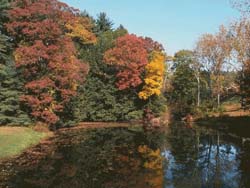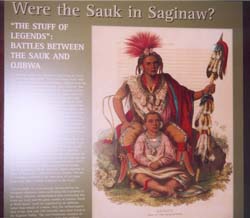
Home
- Artifacts
- Buildings & Businesses
- Churches
- Holidays & Celebrations
- Counties/Locations
- Delta College
- Early Settlers
- Ethnic Background
- Local, Michigan, U.S. and World Events
- Family Genealogy
- Farming
- Libraries & Museums
- Local Sites
- Logging
- Musicians, Artists & Famous People
- Nature, Weather & Four Seasons
- Railroads
- Schools
- Sports
Introduction
 The Michigan Chippewa Indians used all aspects of the earth wisely, were very good hunters, and fierce fighters. I have Chippewa blood in my heritage that I am very proud of. These values still run very deep in my family, even though the bloodline has thinned out.
The Michigan Chippewa Indians used all aspects of the earth wisely, were very good hunters, and fierce fighters. I have Chippewa blood in my heritage that I am very proud of. These values still run very deep in my family, even though the bloodline has thinned out.
My Chippewa Indian Relative
My third great grandfather, Louis Sharrow, was a full-blooded Chippewa Indian. According to family genealogy, while alive he led a great life by fighting for equality in the Civil War and by fighting fires as a Pioneer Assistant Fire Chief. He was 5'8", with dark hair, dark eyes, and a very dark complexion. He was born on February 26th, 1839. He lived in Saginaw all of his eighty-nine years of life, except for the four years that Grandpa Sharrow served in the Civil War. He was one of the first volunteer fire fighters for the city of Saginaw. He later married Emily Jacobs and had eleven children. He is now buried at Michigan Soldiers' Cemetery in Grand Rapids.
The First Indians
 |
| Photo from exhibit at Castle Museum of Saginaw County History |
When the first men came to Michigan, the land was not what we know it today. The glaciers came through and scraped the land into the lakes, rivers, and fertile land we know today. The Chippewa Indians once roamed all of Michigan, but this came with great struggle, because in the Saginaw Valley there were the Sauk Indians. The smart Chippewa tribe planned a surprise attack on them, and the Sauk fought to the death. There were so many dead that an island in the Saginaw River was covered with the dead; this island became known as Skull Island, which we now call Crow Island. A place called Green Point became one of their first sites to set up camp (Gross 2-5).
Hunting
The Indians were not as skillful with the bow and arrow as once thought. To use this weapon you must be at very close range in order to get a vital shot. They preferred to use other sources of weapons: a flint knife, a stone hatchet, and a spear (Gross 8-9). Since hunting was a major source for food and clothes, they had to move about the Saginaw Valley, stalking and preying upon deer, elk, bear, beaver, and otter. These fierce hunters did not just hunt for their meat; they also fished and trapped. The Chippewa did this by using the spear, nets or their bare hands. Although the food was plentiful, they had a problem keeping it from spoiling. They used deep pits dug in to the ground and lined them with bark to keep things from spoiling (Gross 9-10). My family and I still hunt and still use some of these values. We use venison as our main meat and hunt many other game animals.
Food
The Chippewa used their surroundings well; they did this by eating a variety of nuts, berries, and other things that they could get from the land. They gathered nuts, berries, plums, wild rice, and corn; these would be dried and used throughout the year (Gross 10). They also took maple syrup from the trees, refined it, and used it as a flavoring to many vegetables and meat (Densmore 123). The tribe also pounded dried meat into a course substance that the men would eat while hunting (Gross 10). They also ate white potatoes, acorns, and a wide variety of flowers (Densmore 39-40). My family's favorite vegetable is corn; we figure this comes from our Native American heritage. I was always taught to respect the earth and its creatures, and strongly believe that this comes from my Native-American relatives.
Clothing
The Indians wore the clothes that we always think of them in. The men wore a log shirt, a breechcloth, and leggings with a belt that tied the costume together. The women wore a dress with sleeves to the elbows, leggings and a belt. The Indians were also the first to use the idea of fringe on their clothes; this is to shed off any water so the skin doesn't pucker. The Chippewa did not use feathers in the same way as other tribes. The only occasionally used an eagle feather as a medal of honor (Gross 10-12). Instead, they decorated their outfits with colored beads. They also wore moccasins to keep their feet from being sliced by the rough Michigan terrain (Densmore 34).
Transportation
Without the transportation of today, the Indians used their own feet and canoes as their primitive cars. The trails and river ways were used as highways to get where they needed to go (Gross 3). One of the most famous trails is the Mackinaw Trail, which is now Highway 131. It leads to from Detroit to Sault St. Marie and many places in between (Gross 6).
Entertainment
There was not much to do for entertainment, at least not like there is today. Therefore. the Chippewa Indians told stories and other legends of the past. This includes the magnificent attack on the Sauk Indians; they call this legend "Avenging the Sauks" (Gross 3)." They also played music with a wooden flute (Densmore 107). This music was used for a variety of things such as treatment of the sick, and songs of war, love, games, and various dances. Densmore says, "They danced before they went to war and celebrated their victories in the scalp dance" (107). They also played many games; one of these is a guessing game, where one is to guess which object is in which hand (107).
Burial
Did you know that that Saginaw Water Works is one of the main burial sites for the Chippewa Indians? This is a site rich in Native American artifacts, because they believed in live after death and buried the dead with all items they would need for the afterlife (Gross 7). Before the dead were buried they were washed, their hair was braided, and they were put in their best clothes. Another interesting fact is they were always buried with their feet pointing to the east. The thinking behind this was that was the direction they would travel on their journey to the afterlife (Densmore 74).
Villages
The Chippewas lived in large villages they moved with the seasons, and lived together in clans. In the winter they would live in the woods and they would move to the high ground in the summer, usually next to a riverbank. The cool breeze helped to keep away the bugs. The houses were called wigwams, which are oval, with a stick frame and bark covering. The wigwam had a hole in the center of the roof to let out the smoke from the fire. The clans were named after a symbol, for example, the Turtle Clan.
Conclusion
The Chippewa blood may be thinning out in my family, but the ideas of our ancestors are still vary much alive in the way we live our lives. From our hunting to eating habits, we still consider ourselves to be Chippewa Indians. My family and I will always be proud of my Grandpa Sharrow and the things he stood for, because the Chippewa Indians of Michigan used all aspects of the earth wisely, were very good hunters and fierce fighters.
Works Cited
- Densmore, Frances. Chippewa Customs. St. Paul, Minn: Minnesota Historical Society Press, 1979.
- Gross, Stuart D. Indians, Jacks, and Pines. Saginaw, MI: Stuart D. Gross, 1962.
| The written and visual works in Mid-Michigan Remembers-Stories about Us were chosen on the basis of their quality, diversity, community interest and appeal. Views expressed do not necessarily reflect those of the College. This space is provided as a service by Delta College. |